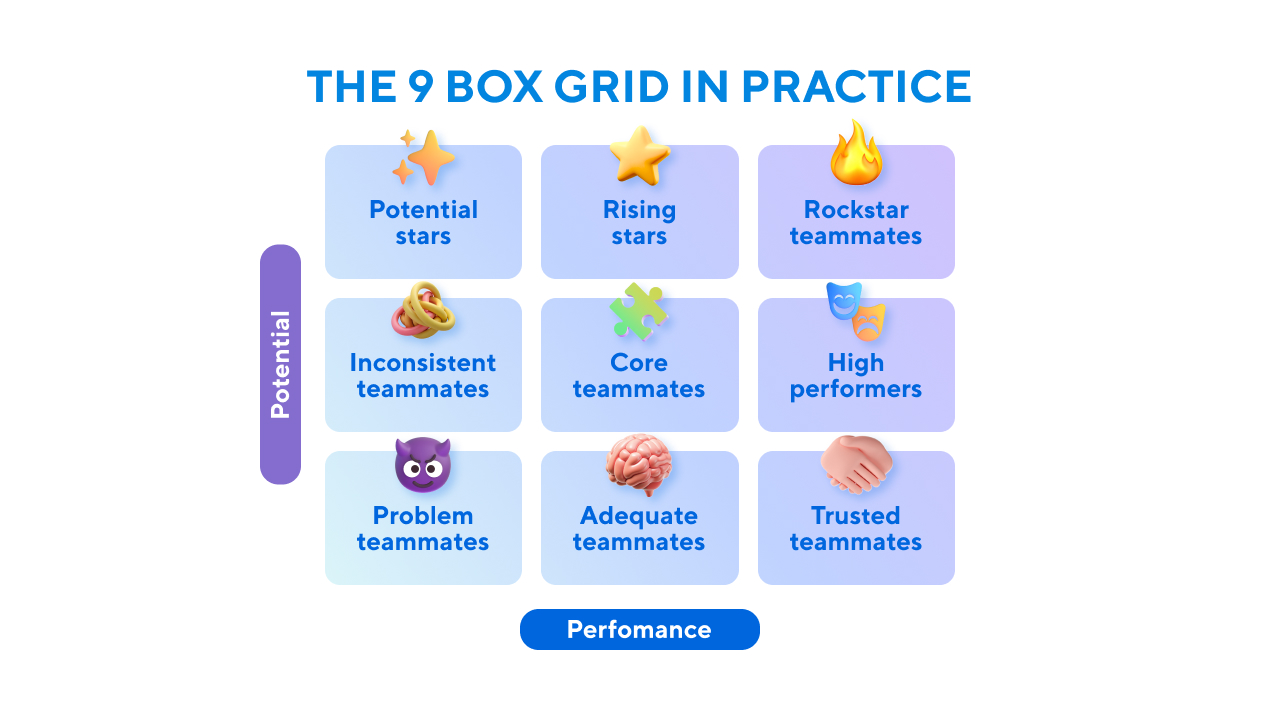Building a dream team is every manager’s dream. But very few people manage to get anywhere near the ideal result.
Personnel selection is one of the most important factors in creating a friendly team that will pull a project or task in a common direction.
In order to find compatible participants, an effective method of assessing their talents and skills is required.
The 9-box grid can be used for this purpose.
The method of assessing talents for their subsequent application in a team will be useful not only for HR managers, but also for managers. First, the essence of the methodology.
Principles of the 9-box talent matrix
Imagine a simple coordinate system: the horizontal axis represents an employee’s performance and the vertical axis represents his or her future potential.
Efficiency is easy to correlate with specific work results: compliance with standards, number of complaints, problems solved or not, and so on.
Unlike efficiency, potential is difficult to measure with specific criteria, but it is also available and easy to track. Different employees have different aspirations for career growth, for improving their professional skills and knowledge, for investing in their education, etc.
Nobody needs specific results for these parameters. An assessment in the form of a low, medium or high level is sufficient.
The methodology includes the following main steps:
- Drawing up a list of employees to be assessed. This can be the entire company, a specific department or service, or only certain specialists.
- Direct evaluation. In order to obtain an objective assessment of performance, it is necessary, for example, to cover a significant period of an employee’s work in the company or any period of time (e.g. a year or a quarter). The most important indicators for the company can be included in the evaluation of performance skills: sales, number of completed transactions or customers acquired, volume of products manufactured, etc. The assessment can have a complex scoring system, but ultimately the result will have to be reduced to a ‘low/medium/high’ system. To assess potential, personal interviews can be conducted, performance data can be collected from line managers or peers, etc.
- Analysis of the results. It remains to classify the employees in 9 segments (9 boxes) according to the scores obtained. The picture below makes it easier to understand the method.

For example, Group 3C would include employees who were ‘low’ on both the performance and potential scales. And Group 1A would include those who were the best at everything, on both the performance and potential scales.
Type of employees according the 9 box grid
Problem teammates
The most undesirable people in the company are from the 3C group. They have low potential and low performance. Managers know that such employees are always a high risk. They may not come to work at all times, they have no incentive to develop within the company, they have no ambition, they may let the team down and simply not do their part.
Action plan
It is possible that an employee has joined the team by chance, or that there are circumstances that prevent them from working properly and benefiting the company.
To rule out all possible problems, it is necessary to work with such an employee separately and find out if there are any obstacles, personal problems or life difficulties.
If there are no such problems, the employee can be offered another position — less responsible or more interesting for them, according to their professional skills and real opportunities (productivity).
Adequate teammates
All workers in the 3B box belong to this group. Their potential is low and their productivity and efficiency are average.
These employees usually require more attention from management: they can become problem teammates at any time.
Action plan
Because of their lack of potential, it is often pointless to invest time and money in their development and training. At the same time, they can simply work without distracting anyone. If you want to increase their efficiency, you need to develop an individual development plan for them.
Trusted teammates
All from the 3A box. High efficiency but low potential. They don’t need control or attention, they just do their job and do it well.
Action plan
In reality, a leader can leave things as they are. These are the ideal performers. It is bad if some managers have been given this status. In this case, you should consider transferring them to the position of a rank-and-file specialist. They will be more effective there.
You must take care of this group of employees and not allow them to be abused. If such an employee decides that his work is not valued, his productivity may drop sharply.
Inconsistent Teammates
Section 2C. Anyone with average potential but low efficiency falls. Another group of employees who need special attention from managers.
Action plan
First, the manager should find out what might be preventing such an employee from working more efficiently. For example, low productivity may be due to a lack of experience, some mistakes in the management and adaptation process, or a misunderstanding of tasks and goals.
The situation can easily be remedied with the help of an internal mentoring system, where more experienced and productive employees teach the details to those who are not doing well.
It is best to monitor such employees in a dynamic way. This can be done through regular knowledge surveys, individual development plans, interviews and more.
If you let things slide, inconsistent teammates can easily move up the status of problem teammates.
Core Teammates
Section 2B. Average efficiency and potential. Nothing out of the ordinary, but nothing bad either.
In fact, most people in your team should be in this section. And if it doesn’t, you should raise the alarm.
Action plan
This is the one category where nothing can be done. On the contrary, a manager should aim for a situation where all his subordinates are the core of the team.
You only need to do something if you don’t have any stars and high performers, but you need them. In this case, you can activate this group through training, motivational talks, coaching, rotation, etc.
High performers
Section 2A is characterised by medium potential and high productivity. Having them is even better than having trusted teammates They are ambitious and know their job well.
Action plan
It is very important to monitor the level of motivation. It is logical to involve them in working on difficult tasks, but do not overdo it. Hard work should be rewarded.
Try to encourage them more and, if possible, move them up the career ladder.
Potential stars
Section 1C. They have low efficiency but high growth potential. In other words, they have the desire to develop, but their existing skills do not allow them to work properly.
Action plan
It is necessary to take such employees under special control. To increase their efficiency, you need to invest time and effort in their training. But if an employee does not want to learn, even though they have serious ambitions, they will hinder rather than help the manager.
In this case, it is better for them to find a position that matches their skills.
Rising stars
Average performance (efficiency) but maximum ambition and potential. An interesting group, breathing down the necks of their Rockstar teammates.
Action plan
At the very least, the manager should give these people a chance to prove themselves. Maybe they just haven’t had a chance to show what they can do.
But there is a nuance here: if the rising star is not confirmed as a new rock star, the employee may lose all potential and move into one of the unfavourable sections of the matrix.
Since ambition will never rest with such a specialist, it is necessary to channel it in a peaceful direction and, if possible, use it for the benefit of the individual and the organisation.
The right balance requires training, coaching, challenging tasks, etc.
Rockstar teammates
Maximum potential and efficiency. Ideal candidate for career progression. Like a locomotive driving the team forward.
Action plan
Rock stars need to be kept on their toes. Not only are they not afraid of difficult tasks, they love them. Otherwise they just get bored. If it is not possible to promote them in the short term, use them as assistants in your tasks. This will give them a chance to prove themselves and keep them busy for a while.
Performing managerial tasks will also allow them to gain the necessary experience, which may be useful elsewhere if they are unable to move up the career ladder in this company.
And most importantly, try not to put a spoke in their wheel. You will not be able to keep the rock stars in place anyway, their ambitions will not allow it. On the contrary, you need to encourage their personal and professional growth in every possible way.
How to plan talent management
Using the 9-box grid, you can get a real picture of the relationship between the professional skills and aspirations of your subordinates. Based on this matrix, it will be much easier to plan the talent pool and organise the right training for your employees.
To ensure that nothing is forgotten or overlooked, use specialised software such as a human resources management system.
Don’t forget to take into account your subordinates’ past performance (not just their current performance), introduce clear and appropriate evaluation criteria, and keep the history and results for future analysis.
Be as objective as possible and remember to identify blocking factors.
